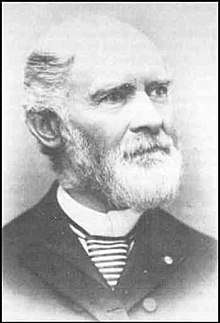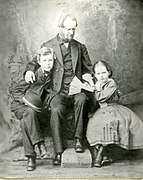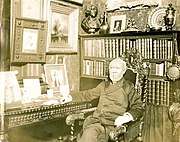Thomas Barbour Bryan
Thomas Barbour Bryan (December 22, 1828 in Alexandria, Virginia – January 26, 1906 in Washington, D.C.) was an American businessman, lawyer, and politician.
Thomas Barbour Bryan | |
|---|---|
.jpg) | |
| Commissioner of the District of Columbia | |
| In office December 3, 1877 – July 1, 1878 | |
| Personal details | |
| Born | December 22, 1828 |
| Died | January 26, 1906 (aged 77) |
| Political party | Republican |
| Other political affiliations | Democratic |
| Alma mater | Harvard University |
| Signature | |
Born in Virginia, a member of the prestigious Barbour family on his mother's side and a great-nephew of Daniel Boone on his father's side, Bryan largely made a name for himself in Chicago, Illinois. Bryan was involved in many ventures in the city, such as the creation of Graceland Cemetery, and was active in the city's politics, having twice been nominated for mayor. Bryan was a strong unionist during the American Civil War. Bryan was instrumental in Chicago being awarded the World's Columbian Exposition, and was involved in the exposition's organization and operation.
Bryan also played a key role in the development of the Chicago suburb of Elmhurst, Illinois, where he resided much of his life.
In addition to his involvement in Chicago politics, Bryan spent a brief period as a Commissioner of the District of Columbia.
Early life, education, and family
Bryan was born in Alexandria, Virginia on December 22, 1828.[1][2] His father was Daniel Bryan, and his mother was Mary Thomas Bryan (née Barbour).[2][3] Bryan's father was a poet and a lawyer, abolitionist, and statesman who served from 1821 to 1853 as Alexandria's postmaster, and who, from 1818 through 1820 served in the Senate of Virginia.[2][3][4]
A member of the esteemed Barbour family through his mother, Bryan's maternal uncles were James Barbour and Philip Pendleton Barbour.[2] His maternal grandfather was Thomas Barbour.[5] Bryan's nephew, would be Bryan Lathrop, with whom he would later form a personal and business relationship.[6] Another nephew would be Barbour Lathrop. Bryan was first cousins with Sextus Barbour.
Bryan's paternal great-uncle was Daniel Boone.[3] His paternal grandfather had been William Bryan, one of the founders of Bryan Station, and his maternal grandmother had been Mary Boone Bryan.[7][8]
Bryan was educated at Virginia's top preparatory schools.[2]
For four years, Bryan held a clerkship with the post office that his father oversaw. The clerkship paid $300 annually, which Bryan saved up before leaving to attend Harvard University.[9]
Bryan graduated from Harvard Law School in 1848.[1]
Adult life and career
After graduating from Harvard Law School, Bryan practiced law in Cincinnati until 1852.[1]
In 1850, Bryan married Jennie Byrd Page, who became Mrs. Jennie Byrd Bryan.[10]
In 1852, Bryan and his wife moved to Chicago, where he had acquired broad real estate interests.[11] Over the next half-century, Bryan would be a booster in the growth of the city.[1]
Sometime between 1856 and 1959, Bryan settled in Cottage Grove, Illinois (modern-day Elmhurst), building a 1,000 acre estate there named "Byrd's Nest".[11][12][13] Bryan would ultimately play an important role in the development of the town, even being credited as the one responsible for renaming the town.[11][12] Living there, he would commute daily to Chicago on the Chicago and North Western Railway.[12] In the 1860 United States Census, Bryan was recorded to be the wealthiest person in DuPage County, Illinois, with a net worth said to exceed $325,000.[12] In 1864, he would sell 26 acres of his land to his brother-in-law Jedediah Lathrop, where Lathrop built his own estate named Huntington.[14]
He and his wife Jennie had three children; two of whom (a son and a daughter) would live to adulthood.[15] The son they lost as a child was named Daniel Page Bryan.[15] Their adult son was Charles Page Bryan, who would have a career as a lawyer and diplomat.[16] Their daughter was also named Jennie Byrd Bryan. She would become a prominent artist and philanthropist, and would marry John Barton Payne, adopting his surname.[17]
In 1860, Bryan established Graceland Cemetery. He was the inaugural president of the Graceland Cemetery Association.[18] The year also saw the opening of Bryan Hall, a music hall which Bryan constructed in Chicago on Clark Street across from the city's courthouse. With a capacity of between 500 and 600 people, it was reported to be the largest hall of its kind in the metropolitan area at the time of its opening.[12][19][20] It would remain the city's primary venue until the opening of Crosby's Opera House .[2]
Bryan established a reputation for himself as a gifted orator.[10]
Bryan was, twice, reluctantly a nominee for mayor of Chicago.[2] In 1861, Bryan was the Democratic nominee for mayor of Chicago. He lost the election to Republican Julian Sidney Rumsey. He was the Republican nominee for the office in 1863, losing by an incredibly narrow margin to incumbent mayor Francis Cornwall Sherman.
During the American Civil War, Bryan funded a company of the 105th Infantry Regiment of Illinois Volunteers in the Civil War, named the "Bryan's Blues".[12] He was a member of the Union Defense Committee.[1] He was also president of the Northwestern Sanitary Fair, an event held in 1865 along the Chicago lakefront which raised more than $270,000 for union soldiers.[1][21][22][23]
Bryan served in leadership roles for numerous Chicago organizations. From 1865 until 1906, Bryan served as president of the Chicago Soldiers' Home.[24] He was president of the Union League Club of Chicago.[1][24]
In 1870, Bryan leased Bryan Hall to Richard M. Hooley for a period of five years, for $21,000 per year. It was renamed the Hooley Opera House.[19]
In 1871, Bryan and his wife Jennie gave 30 acres of land to the German Evangelical Synod of the Northwest for a seminary, which would eventually became Elmhurst College.[25]
In the Great Chicago Fire of 1871, Bryan lost $2 million, with one significant part of this being the loss of his music hall in the fire.[12] After the fire, he provided a number of people displaced with refuge at Byrd's Nest.[12] Bryan was involved in helping revive the city after the fire.[11] Shortly before the fire Bryan had founded the Federal Savings Bank and Safe Depository, also known as the Fidelity Safe Deposity.[1][26] Despite the burning of its building, the vaults and safes were intact, and their contents survived the fire.[26] Bryan rebuilt a new structure for the institution quickly after the fire.[27]
From December 3, 1877 through July 1, 1878, Bryan served as Commissioner of the District of Columbia.

Bryan fell victim to what ultimately turned out to be scam run by H. H. Holmes, later discovered to be a serial killer. He lost more than $9,000 after gotten involved in Holme's scam "A.B.C. Copier Company" at the advice of Bryan's associate Fred Nind.[18] Holmes would fraudulently use Bryan's name on the papers of this and a number of other scam companies.[18][28]
Bryan was a leading figure in the effort to bring the World's Columbian Exposition to Chicago. Bryan convinced the Chicago City Council to pass legislation that would help the city in its efforts secure the world's fair.[11] He, alongside Chicago mayor DeWitt Clinton Cregier and former Illinois Central Railroad president Edward Turner Jeffery gave the presentation for Chicago's bid to the fifteen member United States Senate committee that decided what location would be awarded the fair.[11]
After Chicago landed the fair, he was appointed a commissioner-at-large of the World’s Columbian Exposition Board created by federal legislation.[12] He was ultimately the vice president of the World's Columbian Exposition, vice president World's Congress Auxiliary, Commissioner General of the Exposition and the Chairman of the Congresses Committee of Organization, and President of the World's Congress.[12][28][29]
Patronage of George Peter Alexander Healy
Bryan commissioned many works by George Peter Alexander Healy.[33][34] Healy had an acquaintanceship with Bryan. In 1857, Healy had purchased a cottage in Cottage Hill (Elmhurst) from Bryan, where his Healy lived for next six years, making them neighbors with Bryan during this period.[34][35] After Bryan's death, many of the paintings that he had commissioned from Healy would pass to his daughter Jennie Byrd Payne.[36] After her 1919 death,[17] in 1920, Jennie Byrd's Payne's widowed husband, John Barton Payne, gifted a collection of forty masterpieces to the State of Virginia, a gift valued at time at over $1 million.[36] In this gift were several paintings Bryan had commissioned from Healy.[36]
Collector of historic memorabilia
In his life, Bryan acquired several noteworthy pieces of historic memorabilia.
After the Great Chicago Fire, Bryan purchased the broken remains of the bell from the city lost courthouse at an auction. He kept parts of the bell, but sold most of the bell's remains to H.S. Everhart & Company, who made one-inch tall miniature bells as souvenirs.[37] The courthouse bell was notable in relation to the fire, as it had been one of the bells in the city that was rung to warn citizens of the fire.[38]
After notable people had been invited to send items to the Northwestern Sanitary Fair to auction, Abraham Lincoln sent the original draft of the Emancipation Proclamation.[39] Bryan was successful in bidding for it, paying $3,000 for it, the item being the highest bid item on auction.[39][40] Bryan had lithographic copies made and sold for the benefit of the Sanitary Commission.[39] Bryan gifted the document to the Chicago Soldier's Home, who in turn entrusted it to the Chicago Historical Society for safekeeping. However, this original document was lost in the Great Chicago Fire.[40]
Gallery
 Bryan with son Charles and daughter Jennie circa 1865
Bryan with son Charles and daughter Jennie circa 1865 Bryan hosting the World's Columbian Exposition Commissioners at his Byrd's Nest estate in 1893
Bryan hosting the World's Columbian Exposition Commissioners at his Byrd's Nest estate in 1893 Bryan circa 1900
Bryan circa 1900
References
- Thayer, William Roscoe; Castle, William Richards; Howe, Mark Antony De Wolfe; Pier, Arthur Stanwood; Voto, Bernard Augustine De; Morrison, Theodore (1906). "The Harvard Graduates' Magazine, Volume 14". Harvard Graduates' Magazine Association. p. 543. Retrieved 9 May 2020.
- Biographical Sketches Of The Leading Men Of Chicago, written by the Best Talent of the Northwest. Chicago: Wilson & St. Clair, Publishers. 1868.
- "Edgar Allan Poe Society of Baltimore - People - Daniel Bryan". www.eapoe.org. Edgar Allen Poe Society of Baltimore. Retrieved 9 May 2020.
- "Bryan, Daniel (ca. 1789–1866)". www.encyclopediavirginia.org. Retrieved 6 May 2020.
- "Mary Thomas Barbour Bryan (1795-1884) - Find A..." www.findagrave.com. Retrieved 10 May 2020.
- "Remembering Bryan Lathrop". Glessner House. 28 May 2016. Retrieved 9 May 2020.
- "Daniel Bryan (1795-1866)". spenserians.cath.vt.edu. Retrieved 10 May 2020.
- "Mary Boone Bryan". www.usgenwebsites.org. Retrieved 10 May 2020.
- Hentz, Charles Arnould (2000). A Southern Practice: The Diary and Autobiography of Charles A. Hentz, M.D. University of Virginia Press. p. 510. ISBN 978-0-8139-1881-5.
- "History Highlight: Thomas Barbour Bryan and Elmhurst | Facebook". www.facebook.com. Elmhurst History Museum. 2 November 2018. Retrieved 10 May 2020.
- Wilson, Nancy (2013). "EHM HISTORICAL HIGHLIGHTS Thomas Barbour Bryan (1828 – 1906)". emhurst.org. Elmhurst History Museum. Retrieved 8 May 2020.
- Breslin, Mary (9 March 1997). "BYRD'S NEST DRAWS SETTLERS AFTER CHICAGO FIRE". chicagotribune.com. Chicago Tribune. Retrieved 6 May 2020.
- "Elmhurst, IL". www.encyclopedia.chicagohistory.org. Retrieved 9 May 2020.
- "ARCHITECTURAL RESOURCES in the YORK-COTTAGE HILL SURVEY AREA ELMHURST, ILLINOIS Summary and Inventory". Prepared for the City of Elmhurst by: Ramsey Historic Consultants. 2016. Retrieved 10 May 2020.
- "Thomas Barbour Bryan (1828-1906) - Find A Grave..." www.findagrave.com. Retrieved 9 May 2020.
- "The Political Graveyard: Society of the Cincinnati, politicians, District of Columbia". politicalgraveyard.com. Political Graveyard. Retrieved 7 May 2020.
- Kohler, Sue A.; Carson, Jeffrey R.; Arts, United States Commission of Fine (1978). "Sixteenth Street Architecture". Commission of Fine Arts. p. 104. Retrieved 9 May 2020.
- Johnson, Ray (7 May 2014). "All Chicago Library Branches closed May 7th for H.H. Holmes Execution Day!". Chicago Now. Retrieved 7 May 2020.
- "Bryan Hall". chicagology.com. Chicagology. Retrieved 7 May 2020.
- "Image 1 of Bryan Hall, Clark Street, opposite the Court House. Chicago, Illinois. [Chicago, 186-]". Library of Congress, Washington, D.C. 20540 USA. Retrieved 7 May 2020.
- "Thomas Barbour Bryan". jerrybryan.com. Retrieved 9 May 2020.
- "The Northwestern Sanitary Fair". The New York Times. 9 March 1865. Retrieved 9 May 2020.
- "The Great North-Western Sanitary Fair opens in Chicago, Illinois | House Divided". hd.housedivided.dickinson.edu. Dickinson College. Retrieved 9 May 2020.
- Herringshaw, Thomas William (1909). "Herringshaw's National Library of American Biography: Contains Thirty-five Thousand Biographies of the Acknowledged Leaders of Life and Thought of the United States; Illustrated with Three Thousand Vignette Portraits ..." American Publishers' Association. p. 472. Retrieved 10 May 2020.
- "A Spartan Beginning At Elmhurst College". Retrieved 2015-08-08.
- "Fidelity Safe Deposit Building I". chicagology.com. Chicagology. Retrieved 9 May 2020.
- "Federal Savings Bank and Safe Depository II". chicagology.com. Chicagology.
- "The Art Institute of Chicago". www.vamonde.com. Vamonde. Retrieved 7 May 2020.
- "The Rookery Building". www.vamonde.com. Vamonde. Retrieved 7 May 2020.
- "Jennie Byrd Page Bryan (1829-1898) - Find A Grave..." www.findagrave.com. Retrieved 10 May 2020.
- Illinois, Military Order of the Loyal Legion of the United States Commandery of the State of (1912). Memorials of deceased companions of the Commandery of the State of Illinois, Military Order of the Loyal Legion of the United States. pp. 322–328.
- "29 Jan 1906, Page 3 - The Washington Post at Newspapers.com". Newspapers.com. The Washington Post. 29 January 1906. Retrieved 9 May 2020.
- "Look-alike". www.longcamp.com. Retrieved 10 May 2020.
- "George Peter Alexander Healy (1813-1894)". Illinois Historical Art Project. Retrieved 10 May 2020.
- "Elmhurst". DuPage County Historical Society. 23 September 2019. Retrieved 10 May 2020.
- "The Spokesman and Harness World, Volume 36". Spokesman Publishing Company. 1920. Retrieved 10 May 2020.
- Bales, Richard F. (18 April 2005). "The Great Chicago Fire and the Myth of Mrs. O'Leary's Cow". McFarland. p. 26.
- Billock, Jennifer (24 January 2018). "Five Places Where You Can Still See Remnants of the Great Chicago Fire". Smithsonian Magazine. Retrieved 9 May 2020.
- Schroeder-Lein, Glenna R. (18 October 2012). "Lincoln and Medicine". SIU Press. p. 68. Retrieved 10 May 2020.
- "DHHS Publication No. (NIH)". Department of Health and Human Services. p. 103. Retrieved 10 May 2020.